The AMD Radeon R9 290 Review
by Ryan Smith on November 5, 2013 12:01 AM EST- Posted in
- GPUs
- AMD
- Radeon
- Hawaii
- Radeon 200
Compute
Jumping into pure compute performance, this is another scenario where the 290X shouldn’t throttle as much, and as such the performance differences between the 290 and 290X should be closer to what they are on paper. With compute workloads the ROPs aren’t being hit hard, so that’s power and thermal savings that lets both cards operate at close to their maximum boost clocks.
As always we'll start with our DirectCompute game example, Civilization V, which uses DirectCompute to decompress textures on the fly. Civ V includes a sub-benchmark that exclusively tests the speed of their texture decompression algorithm by repeatedly decompressing the textures required for one of the game’s leader scenes. While DirectCompute is used in many games, this is one of the only games with a benchmark that can isolate the use of DirectCompute and its resulting performance.
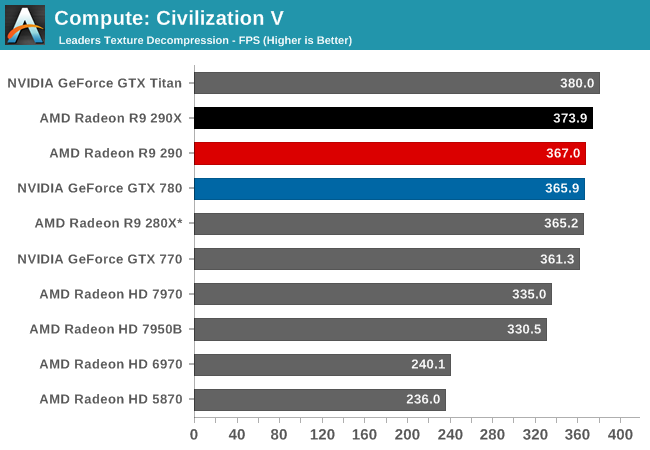
As with the 290X, Civ V can’t tell us much of value due to the fact that we’re running into CPU bottlenecks, not to mention increasingly absurd frame rates. The 290 is marginally slower than the 290X due to the lower clockspeeds and missing CUs, but minimally so.
Our next benchmark is LuxMark2.0, the official benchmark of SmallLuxGPU 2.0. SmallLuxGPU is an OpenCL accelerated ray tracer that is part of the larger LuxRender suite. Ray tracing has become a stronghold for GPUs in recent years as ray tracing maps well to GPU pipelines, allowing artists to render scenes much more quickly than with CPUs alone.
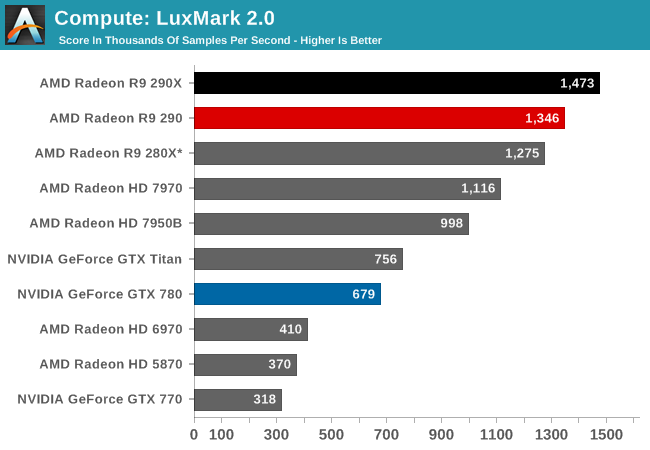
With both cards unthrottled and bound solely by shader performance, it’s an outright foot race for the Radeon cards. 290 trails 290X by around 9%, closely mirroring the difference in the CU count between the two cards. Though 290 is being very closely chased by the 280X, as Hawaii in general seems to have trouble getting the most out of its shader hardware on this benchmark.
Our 3rd compute benchmark is Sony Vegas Pro 12, an OpenGL and OpenCL video editing and authoring package. Vegas can use GPUs in a few different ways, the primary uses being to accelerate the video effects and compositing process itself, and in the video encoding step. With video encoding being increasingly offloaded to dedicated DSPs these days we’re focusing on the editing and compositing process, rendering to a low CPU overhead format (XDCAM EX). This specific test comes from Sony, and measures how long it takes to render a video.
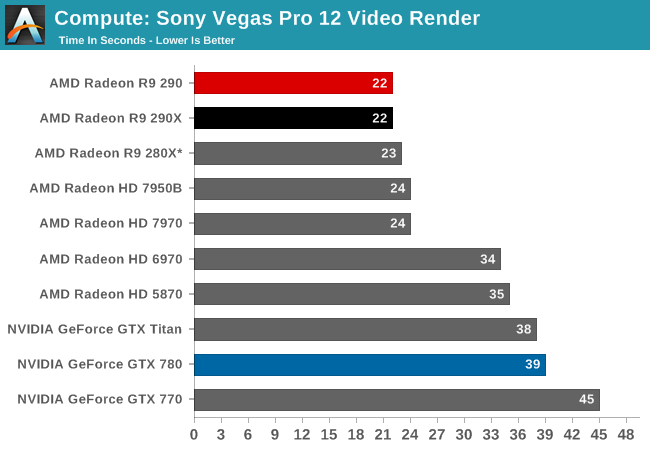
There’s not enough of a GPU performance difference between the two cards to matter with this test. Both tie at 22 seconds.
Our 4th benchmark set comes from CLBenchmark 1.1. CLBenchmark contains a number of subtests; we’re focusing on the most practical of them, the computer vision test and the fluid simulation test. The former being a useful proxy for computer imaging tasks where systems are required to parse images and identify features (e.g. humans), while fluid simulations are common in professional graphics work and games alike.
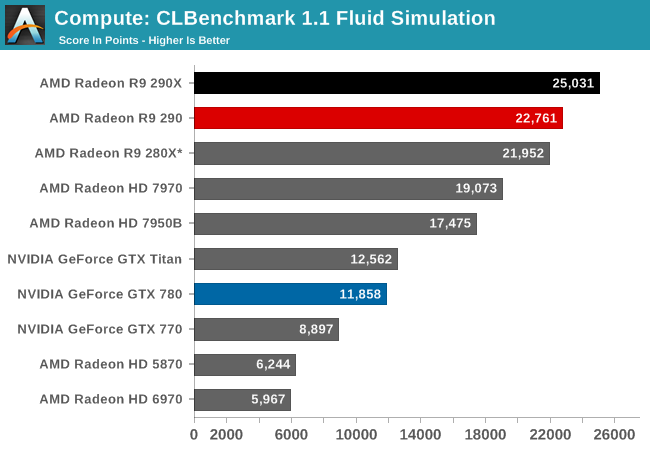

In the CLBenchmark fluid simulation the 290X and 290 take the top spots as expected, with the 290 trailing once more by 9%. However both Hawaii cards are still struggling with the computer vision benchmark, leading to the 290 being edged out by the 7970 of all things.
Moving on, our 5th compute benchmark is FAHBench, the official Folding @ Home benchmark. Folding @ Home is the popular Stanford-backed research and distributed computing initiative that has work distributed to millions of volunteer computers over the internet, each of which is responsible for a tiny slice of a protein folding simulation. FAHBench can test both single precision and double precision floating point performance, with single precision being the most useful metric for most consumer cards due to their low double precision performance. Each precision has two modes, explicit and implicit, the difference being whether water atoms are included in the simulation, which adds quite a bit of work and overhead. This is another OpenCL test, as Folding @ Home has moved exclusively to OpenCL this year with FAHCore 17.
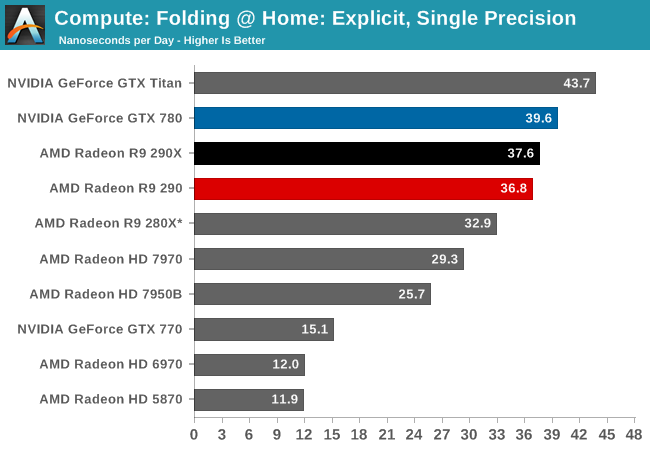
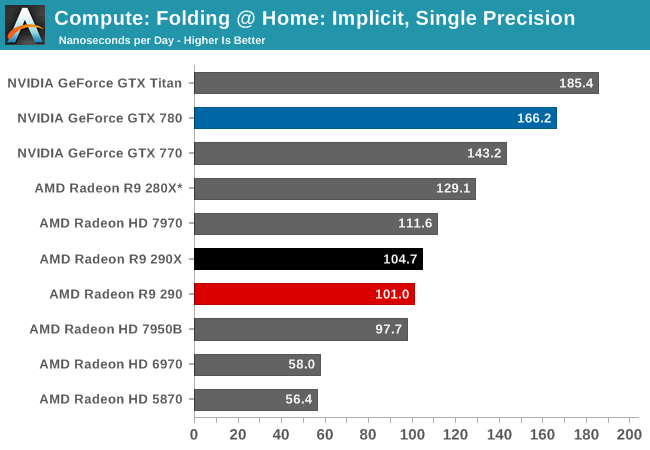
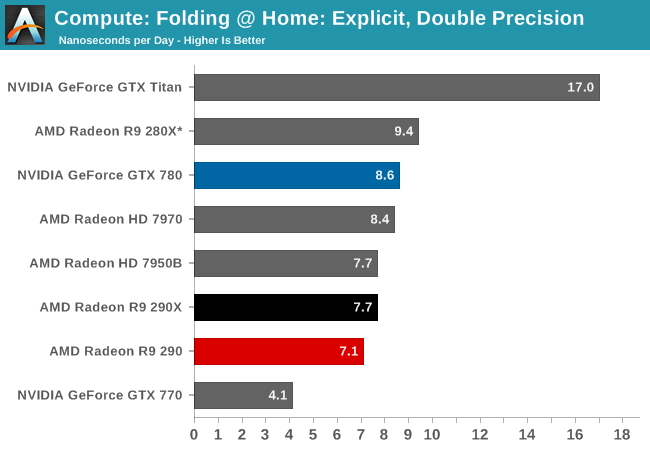
Generally Tahiti and Hawaii are strong performers in the GPU compute arena, but that isn’t of particular help to the 290 here, as it loses out to the GTX 780 in every mode. In single precision FAHBench has trouble putting Hawaii to good use at times, while double precision tests have the 1/8th DP rate 290 and 290X falling behind due to their lower than Tahiti DP throughput.
Wrapping things up, our final compute benchmark is an in-house project developed by our very own Dr. Ian Cutress. SystemCompute is our first C++ AMP benchmark, utilizing Microsoft’s simple C++ extensions to allow the easy use of GPU computing in C++ programs. SystemCompute in turn is a collection of benchmarks for several different fundamental compute algorithms, as described in this previous article, with the final score represented in points. DirectCompute is the compute backend for C++ AMP on Windows, so this forms our other DirectCompute test.
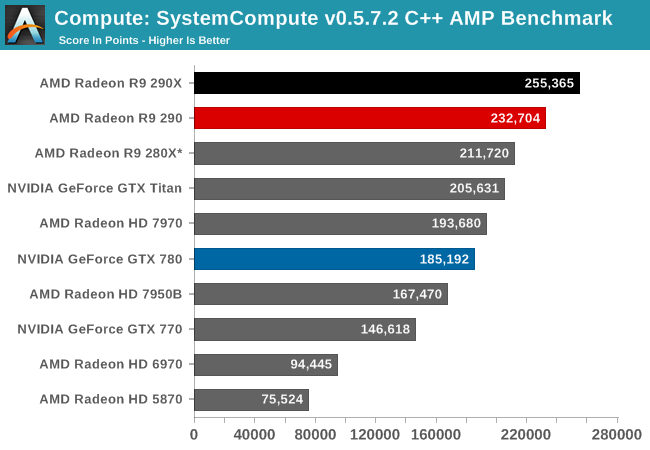
SystemCompute is another benchmark where 290 and 290X do not experience meaningful throttling, and as such are separated by more than what happens in our gaming benchmarks. In this case 290 yet again trails 290X by 9%, though it still enjoys a considerable lead over the GTX 780 and all other NVIDIA cards.










295 Comments
View All Comments
just4U - Wednesday, November 6, 2013 - link
You have to ask yourself is Ryan biased with Nvidia or AMD... or maybe it's simply just his tolerance for noise that is the issue.Anyway.. people buying these cards will have some options. For me the 95C is a no go as is the noise. Something I'd tolerate until a good aftermarket solution could be implemented. AMD and Nvidia (until their titan reference cooler) have always been a little meh.. with reference coolers. We all know this..
My last two cards have been AMD ones and if I was in the market for a card today I'd go straight for the Nvidia 780. Not because of it's speeds, certainly not because of its drivers, and not because I am a fan. I simply like their kickass reference cooler and games bundle.
Im not in the market though lol. Quite happy with my Radeon 7870.. and not looking to upgrade yet.
jbs181818 - Thursday, November 7, 2013 - link
With all that power consumption, what size PSU is required? Assuming 1 GPU and a haswell CPU, 1 SSD.dwade123 - Thursday, November 7, 2013 - link
290x doesn't make sense when the cheaper 290 performs almost identical. And neither can max out Crysis 3. Gamers are better off waiting for real next-gen cards like Maxwell, and with next-gen console ports coming in 2014 suggests it is common sense to do so.polaco - Tuesday, November 12, 2013 - link
"neither can max out Crysis 3" what the hell are you talking about?52 fps at 2560x1440 HQ + FXAA
77 fps at 1920x1080 HQ + FXAA
with that line of thinking then nor 780 or Titan are worthy since fps diff is minimal
"gamers are better off waiting for real next-gen cards like Maxwell"
well, 290 and 290X are AMD true next gen cards, maybe you feel fooled by having bought a 780 for almost 700 bucks and then you feel like Maxwell will relief that pain, or maybe you work for NVidia marketing deparment... for the time NVidia came out with it AMD will be pushing their next gen too, will you recommend waiting then too? so we wait forever then uh?
"and with next-gen console ports coming in 2014 suggests it is common sense to do so"
you mean to wait for NVidia card to run games that will be optimized to AMD hardware that is inside every next gen console?
please go to see a doctor....
TempAccount007 - Saturday, November 9, 2013 - link
Who the hell uses a reference cooler on any AMD card? The only people that buy reference cards are those who are going to water cool them.NA1NSXR - Monday, November 11, 2013 - link
If I was in the market for a card I'd wait until the aftermarket cooler designs come out. Should make the noise and temp situation a little more bearable. Still, the proprietary nVidia value-adds like HBAO+, adative vsync, TXAA, etc. are hard to give up for me. It is a hard call. If the 780 was only $50 more than the 290 I'd take the 780, but since the difference is $100....I don't know. Really tough call.beck2448 - Tuesday, November 12, 2013 - link
Too noisy and hot.devilskreed - Tuesday, November 12, 2013 - link
Hail High AMD..The gamers saviour!!!Hail High AMD..The price/performance king
Hail High AMD..The peoples choice..
Healthy competition from AMD's side,i stopped buying nvidia after 8800GT :p purely due to price/performance benefits that AMD offers..
bloodbones - Thursday, November 14, 2013 - link
The battle between amd ex ati and nvidia has been around since i was 18 years old and i am 30 now. Over the years i have try a huge numbers of video cards from both companies and the only conclusion is that things have always been the same, nothing change over the years: more or less the same performance and:Nvidia = more expensive cards but more quality cards, lower noise levels lower temps
Ati/Amd = cheaper cards with higher noise levels higher temps
Period.
horse07 - Thursday, November 14, 2013 - link
Guys, when will you update the 2013 GPU benchmarks with the recent R7/R9 and 700 series?